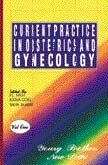|
Current Practice in Obstetrics and Gynaecology. Volume 1
Editors:
K.C. Singh, Neerja Goel, Shalini Rajaram
This book is of general interest to obstetricians and gynaecologists. It is written in the main by Indian doctors (specialists), and is similar in style to the 'Progress in Obstetrics and Gynaecology' and 'Recent Advances in Obstetrics and Gynaecology' series originating from the U.K.
The book is set apart by its inclusion of chapters on several areas of specialist interest. These so-called 'allied topics' include 'Biostatistics in Clinical Practice', 'Blood Transfusion in Obstetrics and Gynaecology', 'Breast Cancer Screening', and 'Internet Sites for Obstetrics and Gynaecology'.
The chapter on biostatistics covers concepts concerning most of the statistics commonly used in clinical studies. This will greatly assist doctors to critically review articles presented in the medical literature. Also helpful, the chapter on internet sites provides information on the quality and usefulness of each of the featured websites.
Other particularly good quality chapters include those on 'HIV and Pregnancy', 'Principles of Crisis Management in Obstetrics', and 'Choice of Hysterectomy for Benign Disease'. The HIV/pregnancy chapter provides doctors with a complete review of the clinical management of HIV-positive pregnant women. Mostly younger doctors and trainees involved in day-to-day management of obstetrics patients will benefit from reading the Crisis Management chapter. Likewise, trainees will profit from perusing the hysterectomy chapter, which helps clarify this common area of confusion.
The chapter on 'Prescribing HRT: Recent Trends' is well written, but there is lack of discussion regarding selective oestrogen receptor modulators (SERMS). Although these drugs are new and may not yet be available in many parts of the world, they appear to be very promising in the field of HRT.1
|
|
The chapter on 'Current Status of Neoadjuvant Chemotherapy in Carcinoma of Cervix' is generally good. However, neoadjuvant chemotherapy has not really been shown to be beneficial over traditional surgery or radiotherapy in the treatment of cancer of cervix. Rather, the benefit of chemotherapy, according to promising results published recently,2-4 is its use in conjuction with radiotherapy so-called 'concurrent chemo-radiotherapy'. Although written before this latest information became available, the chapter does include a brief discussion of this issue.
The chapter on 'Iron Deficiency Anaemia in Pregnancy' does not contain much new information. However, given the prevalence of iron deficiency in India, it is an important inclusion nonethelessd.
Prof. T. N. Leung
References
- Mitlak BH, Cohen FJ. Selective oestrogen receptor modulators: a look ahead. Drugs 1999;57:653-663.
- Morris M, Eifel PJ, Lu J, et al. Pelvic radiation with concurrent chemotherapy compared with pelvic and para-aortic radiation for high-risk cervical cancer. N Engl J Med 1999;340:1137-1143.
- Rose PG, Bundy BN, Watkins EB, et al. Concurrent cisplatin-based adiotherapy and chemotherapy for locally advanced cervical cancer. N Engl J Med 1999;340:1144-1153.
- Keys HM, Bundy BN, Stehman FB, et al. Cisplatin, radiation, and adjuvant hysterectomy compared with radiation and adjuvant hysterectomy for bulky stage 1B cervical carcinoma. N Engl J Med 1999;340:1154-1161. e chapter
|
About the reviewer...
Professor T.N. Leung is Associate Professor at the Department of Obstetrics and Gynaecology, The Chinese University of Hong Kong, Prince of Wales Hospital, Hong Kong.
|
|
|
 Details Details
Title: Current Practice in Obstetrics and Gynaecology. Volume 1 (Hardback w/ soft cover), 247 pages, 1999.
Publishers
Young Brothers, 100, Model Basti, New Delhi - 110006
Price
Rs 300.
|